STANCE #25 – FEBRUARY EDITION
By Annie Handmer
The successful landing of Chang’e-4 on the far side of the moon in January 2019 focussed the world’s attention on the space program of the Peoples Republic of China (PRC). From the early ‘two bombs, one satellite’ policy of the Mao era, the PRC’s development in space technologies has been rapid, and the PRC is on track to be a major space power by 2030.
Australia must carefully consider how we manage international space relations with the PRC as we move into NewSpace (private, rather than government-led, space activities) and Space 2.0. The private space industry is developing fast, driven by a desire for financial, rather than political or ideological, returns. It is more important than ever that national governments prioritise maintaining positive and productive international relationships in space so that they are able to regulate activities consistently, and to manage the risk of military escalation.
Space capability development inherently includes dual-use technology. It requires balancing defence and security on the one hand, and civil and scientific activities on the other. Often, space technology embodies the tension between these uses; an agricultural surveillance satellite could just as easily be put to military reconnaissance purposes.
The ‘dual-use’ problem affects how nations cooperate and collaborate in scientific, military and civil activities in space. The United States restricts NASA from collaborating with the PRC on the grounds that space technologies may have military applications. But Australia, and other nations without a legacy of enormous public funding for science, cannot afford to be so picky.
Last year the Australian Strategic Policy Institute published a report by Alex Joske (‘Picking Flowers, Making Honey’) which states that a growing number of PRC scientists, both students and visiting scholars, are sponsored by the military to travel to academic institutions in foreign countries, including Australia.
Joske contends that the PRC appears to be strategically managing these collaborations to bring cutting-edge scientific expertise back to its own technological and defence development programs. The report recommends that Australia should make it harder for PLA-affiliated researchers to fund, conduct, or participate in research activities in Australia. This recommendation deserves interrogation.
It should come as no surprise that the PRC sends scientists overseas and funds research abroad to gather information and expertise; many countries do. But rather than attempting to stop or slow it, Australia should facilitate and actively manage scientific cooperation with the PRC to build influence and gain information, while maintaining safeguards to mitigate national security risks. Doing so would contribute to Australia’s national security by bringing international scientific cooperation into our Phase Zero operations.
Scientific research in a similar internationally governed sphere, Antarctica, has been a conduit for peaceful and productive cooperation on individual and institutional levels even during times of extreme geopolitical tension, for example cooperation between France, the USA and the USSR (later Russia) at Lake Vostok in the 1980s and ‘90s.
More recently, Australia has formed important bonds with the PRC through co-funded research in Antarctica. In 2008, the University of New South Wales and a several international institutions, including CalTech, Nanjing Institute of Astronomical Optics and Technology, and Tianjin Normal University, deployed an autonomous observatory at Dome A, located within Australia’s Antarctic territory. This program was a collaboration funded by the PRC, Australia, the EU, and the United States.
Beyond benefits for science, the Antarctic logistics economy – the exchange of logistical services by one nation for logistical services from another – has allowed Australia to operate far more widely in Antarctica than our annual budget might otherwise allow.
Australia has a latent claim to 42 per cent of the Antarctic continent, but it is the PRC’s presence on ‘our’ territory that enables us to conduct activities that we could not otherwise afford. Because of this, Australia can also exert important influence in Antarctica in areas such as environmental protection and non-militarisation during cooperative activities with other nations, including the PRC.
With high costs and physical barriers to entry, Australia’s success in NewSpace and Space 2.0 may likewise depend on our ability to cooperate successfully and peacefully with larger space powers such as the PRC.
We should encourage academic relationships between PRC researchers and Australian scientists at non-military institutions, and make the most of these relationships through strategic space diplomacy.
We should not force our underfunded public universities to turn down funding, reject opportunities for collaboration, or refuse talented individuals the chance to experience the best of Australian research, academic freedom, and culture, based simply on country of origin.
The PRC has proven its capability in space. For Australia, refusing to actively cooperate with PRC scientists is a sure way of encumbering our intellectual and technological capabilities and ensuring that we are increasingly reliant on other countries for military and civilian technology in the future.
Annie Handmer is a graduate research student in the School of History and Philosophy of Science at the University of Sydney. Her research is supported by an Australian Government Research Training Program scholarship.
Photo: medium.com

